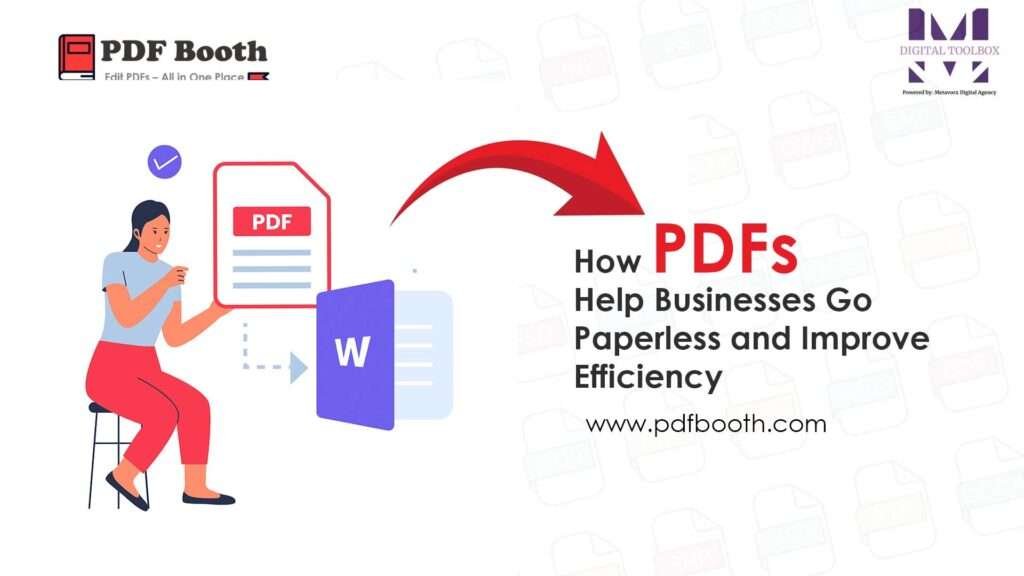How PDFs Help Businesses Go Paperless and Improve Efficiency

In today’s fast-paced digital world, businesses are continuously looking for ways to streamline operations, reduce costs, and promote sustainable practices. Going paperless is one of the most effective strategies to achieve these goals, and Portable Document Format (PDF) files play a significant role in making this transition smooth and efficient.
Why Going Paperless Matters
Reducing paper usage not only helps save trees and protect the environment but also brings cost savings and operational efficiency to businesses. Managing, storing, and sharing paper documents can be time-consuming and prone to errors. Digital files like PDFs offer a solution that is secure, organized, and easily accessible from anywhere.
How PDFs Support Paperless Workflows
1. Easy Document Sharing
PDF files maintain their format across different devices and platforms. Whether you’re sending contracts, reports, or invoices, PDFs ensure that the layout stays intact, eliminating confusion or the need to resend files due to formatting issues.
2. Enhanced Security
PDFs can be password-protected and encrypted, allowing sensitive information to be securely shared. Permissions can also be set to prevent copying, printing, or editing, giving businesses control over who accesses their documents.
3. Improved Collaboration
With the help of annotations, comments, and e-signature tools, PDFs enable teams to collaborate efficiently without the need for physical meetings. Real-time feedback and approvals can be exchanged digitally, speeding up decision-making processes.
4. Efficient Document Storage
Digital PDFs take up far less space than physical files. They can be organized in cloud storage systems, ensuring quick retrieval and eliminating the hassle of filing cabinets. Advanced search options also make it easier to find information.
5. Cost and Time Savings
By reducing printing, copying, and shipping expenses, PDFs help businesses cut costs. Employees can also save time spent on paperwork and manual filing, allowing them to focus on more strategic tasks.
6. Environmentally Friendly Practices
Switching to PDFs helps reduce paper consumption and the carbon footprint associated with printing and transportation. Businesses can contribute to sustainability goals while improving their brand image.
Best Practices for Using PDFs in Business
- Use PDF creation tools that allow you to convert documents from Word, Excel, or other formats easily.
- Implement cloud-based storage solutions like Google Drive or Dropbox to store and access files securely.
- Train employees on using PDFs for collaboration, signing, and sharing to ensure everyone is on the same page.
- Regularly back up digital documents to avoid data loss.
- Use tools that integrate PDFs with project management and communication platforms for seamless workflows.
Conclusion
Adopting PDFs as part of your business’s digital strategy is a practical and effective way to go paperless while improving efficiency. From reducing costs and saving time to enhancing security and collaboration, PDFs offer businesses a reliable format to manage documents in the modern workplace.
Embrace the power of PDFs today and take a step toward a more organized, sustainable, and efficient business environment.
FAQs:
Why are PDFs important for businesses going paperless?
PDFs are important because they preserve formatting across all devices, are secure, and can be easily stored, shared, and signed digitally. This makes them a reliable choice for businesses transitioning to a paperless workflow.
Are PDFs secure for sharing sensitive business information?
Yes. PDFs can be password-protected, encrypted, and restricted from editing or printing. This makes them one of the most secure document formats for sharing confidential business files.
How do PDFs improve efficiency in the workplace?
PDFs reduce the need for printing, filing, and shipping paper documents. They also support collaboration through annotations and e-signatures, allowing faster approvals and streamlined workflows.
Can PDFs integrate with cloud storage and business tools?
Absolutely. PDFs can be stored in cloud services like Google Drive, Dropbox, or OneDrive. Many business platforms and project management tools also support PDF integration for seamless document handling.
